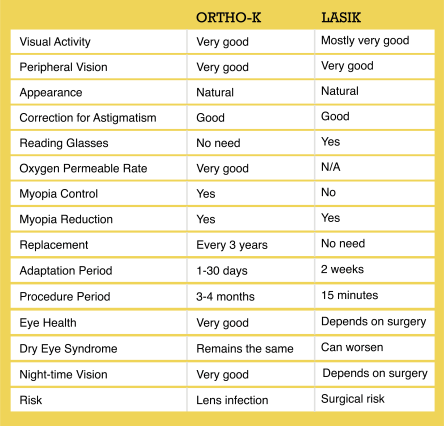
The kid who started using ORTHO-K was observed to have less refractive error and elongation of the axis length.
ORTHO-K is the right way to STOP progression of myopia!
Case Report
Orthokeratology for slowing myopic progression in a pair of identical twins
Ka Yin Chan Sin Wan Cheung Pauline Cho
Sin Wan Cheung Pauline Cho
http://www.contactlensjournal.com/article/S1367-0484(13)00277-4/abstract
Purpose
To compare the axial length elongation and change in refractive errors in a pair of identical twins wearing orthokeratology (ortho-k) and single vision lenses (SVLs), respectively.
Case report
Identical Twin A and B, who were 8 years of age, with the same amount of near activities, were assigned to wear ortho-k and SVLs randomly and they were monitored for two years for myopic progression. Twin A and B were assigned to wear ortho-k and SVLs, respectively. Myopic progression was evaluated by the change in axial length and in refractive errors. A faster axial length elongation was observed in each eye of Twin B during the two-year study period. The overall change in axial length was 0.52![]() mm (OD) and 0.70 (OS) in Twin A and 0.77
mm (OD) and 0.70 (OS) in Twin A and 0.77![]() mm (OD) and 0.82
mm (OD) and 0.82![]() mm (OS) in Twin B. In terms of cycloplegic refractive errors (SER), one month after ceasing lens wear (after completion of the two-year study), the increase (from baseline) were 11% (OD) and 48% (OS) in Twin A and 87% (OD) and 67% (OS) in Twin B.
mm (OS) in Twin B. In terms of cycloplegic refractive errors (SER), one month after ceasing lens wear (after completion of the two-year study), the increase (from baseline) were 11% (OD) and 48% (OS) in Twin A and 87% (OD) and 67% (OS) in Twin B.
Conclusions
Ortho-k is more effective in controlling myopic progression in terms of axial elongation than wearing SVLs in this pair of identical twins.
Keywords: Orthokeratology, Twins, Myopic control, Axial length, Refractive errors
Related Article
Prevent your Eyes from Getting Weaker with ORTHO-K
